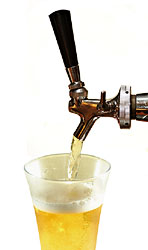 In olden times, beer was stored in wooden casks but in the modern scenario, people mostly use beer kegs. For those who have just stepped in home brewing or are novice in this field, some tips on kegging homebrew are enlisted below.
In olden times, beer was stored in wooden casks but in the modern scenario, people mostly use beer kegs. For those who have just stepped in home brewing or are novice in this field, some tips on kegging homebrew are enlisted below.
- Avoid shaking the keg during transportation as it may result in the formation of unwanted foam. This usually happens when you remove the keg from your car and drag it inside your home. Rolling the keg is a big No- one should always gently handle the keg and keep it upright.
- A corney keg is easy to clean and maintain while a commercial Sankey keg is difficult for the novice. Corney kegs are a good pick as they are compact, they don’t break, and they stack well. They are perfect for secondary fermentation. Although they can be used for primary fermentation too, using them for secondary fermentation helps keep them clean.
- The keg is pressurized with either carbon dioxide gas alone, or nitrogen, or a combination of both the gases. Earlier carbon dioxide was used in kegging systems as people had no choice, but now people all over the world are blending nitrogen with carbon dioxide. The combination of both gases allows an elevated pressure which is ideal for complex dispensing systems.
- Draught beer refers to beer which is stored and served from a keg or cask. While kegging beer, you must always ensure that kegs and kegging equipment are clean. You can simply use a brush and hot soapy water to clean the keg. Use a non-abrasive pad or a sponge for cleaning. Remove all the seals and fittings prior to washing.
Use the tips given above to keg your homebrew and get delicious each and every time.
________________________________________________________
Read More About Kegging And Other Home Brewing Topics,
FREE EMAIL NEWSLETTER:

